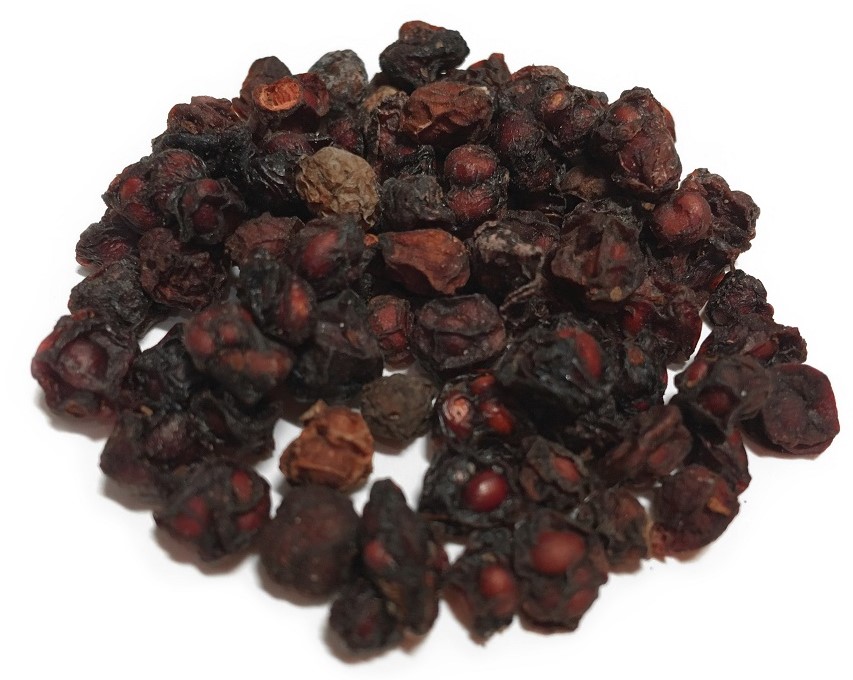Metal of Metal: Wu Wei Zi 五味子
味酸皆屬金,五味[子]為之主,枳實為木,豉為火,芍藥為土,薯蕷為水。
All sour belongs to metal, for it is governed by Wuweizi, and Zhishi is wood,Chi is fire, Shaoyao is earth, and Shuyu [Shan Yao] is water.
Wuweizi or Chinese Schisandra Berry is classified as the Metal of Metal by the Tang Ye Jing. Its flavor is the quintessence of Sour, and the action of Wuweizi perfectly illustrates why the Tang Ye Jing ascribes the action of Sour to Metal.
The Shen Nong Ben Cao Jing’s entry for Wuweizi describes it in this way:
Wuweizi’s flavor is sour, [its temperature] is warm. It governs augmenting qi, cough reversal, surging qi, taxation damage, debilitating emaciation, tonifies insufficiency, strengthens yin, augments male essence.
Wuweizi's association with augmenting qi and treating cough suggest it is an herb with an affinity for the Lungs, which is in keeping with Su Wen Chapter 22's statement that when the Lungs desire to be gathered, urgently eat sour to gather them (肺欲收,急食酸以收之).
Wuweizi is commonly used for treating the Lungs in both the Shang Han Lun and Jin Gui Yao Lue. It appears most frequently with Ganjiang as a two herb modification which is added to other formulas when there is a cough.
 |
| Wuweizi - c/o Kamwo Herbs |
In Line 96, for example, when using Xiao Chai Hu Tang (小柴胡湯) to treat a Shaoyang pattern, we are told that if the condition presents with a cough, we are to remove Renshen, Dazao, Shengjiang and add Ganjiang and Wuweizi. This substitution shifts the formula's action from the Middle Burner (note that Renshen and Dazao belong to the Earth, and Shengjiang is the Earth of Wood) to the Lung and the Upper Burner.
This same modification also occurs in Line 316, which describes a Shaoyin pattern treated by Zhen Wu Tang (真武湯). The line states that when there is a cough, Ganjiang and Wuweizi and Xixin (the Metal of Wood) are added. And we find it again in Line 318, where it is a modification to Si Ni San (四逆散) when there is a cough in addition to the signs of internal constraint with cold extremities associated with the base formula.
We can understand these modifications in light of the statement in Su Wen Chapter 38, that it is not only the Lung which causes cough, but potentially any of the Five Zang and Six Fu (五藏六府,皆令人欬,非獨肺也). These modifications show us how to elegantly treat both the branch (cough) using a modification, as well as the root (the underlying imbalance) with a base formula. And more specifically, the effects of combining Acrid flavors (such as Ganjiang and Xixin) with Sour flavor (Wu Wei Zi) will have a regulating effect on the Lungs. We know this from Su Wen Chapter 22, which states that acrid purges the Lungs while sour tonifies them (用酸補之,辛寫之).
The direction of these two flavors mirror the direction of the Lung's physiology as described by Chinese Medicine. The Lungs are in charge of dissipating and disseminating qi, functions that are promoted by outward movement of the Acrid flavor. The gathering movement of the Sour flavor, meanwhile, promotes the Lung’s descending function as well mirroring the action of inhalation, which is also a kind of gathering of qi. And so it makes sense that the combination of Acrid and Sour will simultaneously drain pathological excess while also protecting the qi of the Lungs.
In addition to being a common formula modification, this combination of Sour and Acrid features in the formula Xiao Qing Long Tang (小青龍湯), a formula indicated for external cold invasion with internal accumulation of dampness in the Lungs. Here as in the modifications discussed, the Acrid (and warm) herbs are used to open and disperse the Lungs, dry dampness and move stagnant fluids. The Sour, moistening Wuweizi is used to gather Lung qi, and it will balance the dispersing, drying action of the Acrid herbs.
This combination of combining opposing flavors to regulate physiology is a common "signature" seen in many of Zhang Zhongjing’s formulas in the Shang Han Lun and Jin Gui Yao Lue. It is also one of the "signatures" of the Fu Xing Jue's formulas. Hopefully this brief exploration of Wuweizi and its usage in classical formulas illustrates how an understanding of the dynamics of flavor and direction can help us grasp formula architecture, and also how the flavor of an herb interacts with the physiology of the organs it is treating.



Comments
Post a Comment